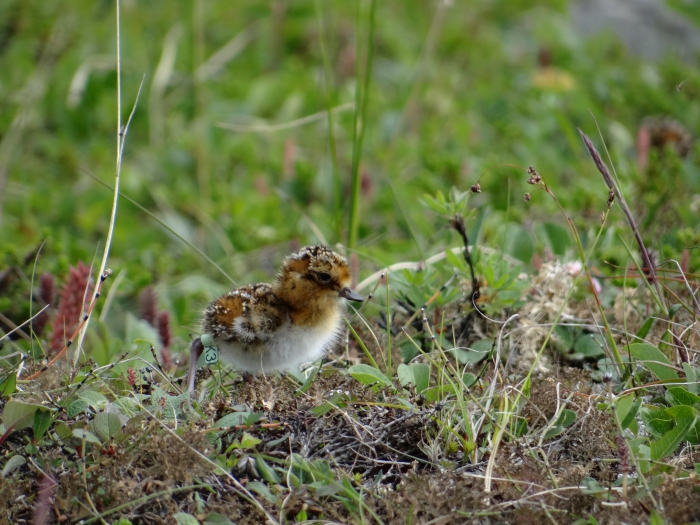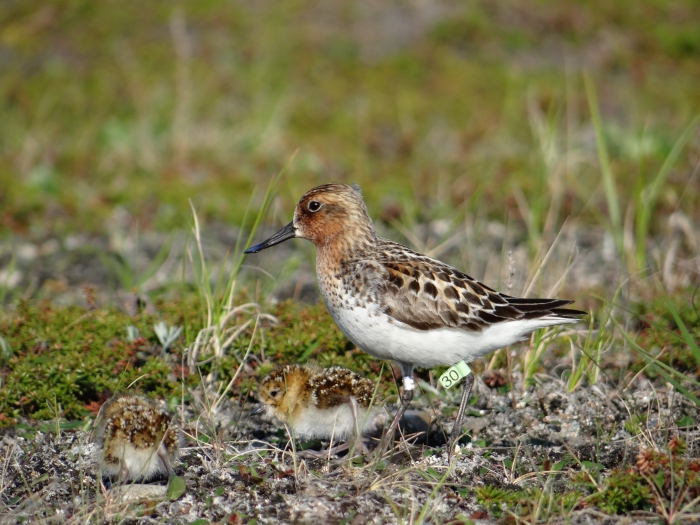By: Dr. Christoph Zockler, Eastern Asian-Australasian Flyway Partnership for the Spoon-billed Sandpiper (EAAFP SBS) Task Force Coordinator Cambridge, U.K.
It is amazing to see how the Spoon-billed sandpiper, a tiny bird no bigger than a sparrow and weighing just 30-45 grams, can raise so much global attention. The tiny shorebird with the charismatic spoon-shaped bill is breeding entirely in the Russian Arctic in Chukotka and Northern Kamchatka. For over 15 years, Birds Russia and the Spoon-billed Sandpiper Task Force have been working to save this tiny globally threatened sandpiper from extinction. In 2000 we discovered the population to be in dire condition. Many known breeding sites in Chukotka were found abandoned or declining. The total population was estimated to be less than 1,000 pairs. Ten years later the population declined further to less than 200 breeding pairs and the global conservation community became alarmed. From research on the breeding ground there was increasing evidence that the main cause for the decline is within the flyway (common migration route) in East Asia. Indeed, the main reason for the decline was the trapping of coastal birds in Myanmar, Bangladesh, and China, but the loss of stopover sites in China and other countries in East and Southeast Asia along the flyway also contributed to the decline.

The small recovery team of six members, established in 2004, merged into a well-established task force of the East Asian Australasian Flyway Partnership (EAAFP) in 2010, chaired by Dr. Evgeny Syrechkovskiy from Russia.
In 2013 the population of the 12-14 remaining breeding pairs were monitored by a Russian research team near the Chukchi fishing village of Meinypilgyno. Birds were individually colour-marked and chicks reared in captivity to avoid predation and released again as fledglings into the wild. This would give the young birds a good head-start for their long journey south to southern Russia, Japan, Korea, China, and the wintering areas in Southeast Asia. For the second time these head-started birds returned to the breeding population and bred! These new recruitments contributed to the increase observed in 2015 for the first time in 14 years. This is a success of the local research and conservation team in Chukotka, who helped to research and to guard the breeding birds from egg and skin collectors as well as stray dogs and natural predators. This success is also the result of the increasing conservation community along the entire Eastern Asian-Australasian flyway, which include the hunting mitigation work on the wintering grounds in Myanmar and in Bangladesh, by the local task force members, and the conservation efforts in Thailand and China. These efforts have shown a positive impact on the population.
Furthermore, the Russian scientists found a new site in July this year, not far west of the known population in Meinypilgyno with at least 18 and maybe as many as 25 breeding pairs. This exciting news provides hope and maybe a little more time for the conservation activities as the current total population might indeed be slightly higher than suspected.

The Spoon-billed Sandpiper is the rarest breeding shorebird in the world and one of the rarest species in the Arctic region. As a flagship species it is symbolic for the entire flyway and represents the current conservation status along the flyway that Russia shares with Alaska and Canada. Conservation efforts for the species will be beneficial for a huge range of species along the flyway, but also for the livelihoods of local people living along the coast. There is also more and more awareness among Arctic stakeholders that conservation efforts for Arctic migratory species need to take the entire flyway into consideration. The Arctic Migratory Bird Initiative (AMBI) by the Arctic Council's Conservation of Arctic Flora and Fauna (CAFF) Programme aims to address exactly that. The Spoon-billed Sandpiper is one of this initiative's few selected flagship species.
Many foundations and international organizations have supported the conservation of the species, including: the Keidanren Fund for Nature (Tokyo) and the Manfred-Hermsen-Foundation (Bremen). Today the main supporters include BirdLife International, the Lighthouse Foundation, the David and Lucile Packard Foundation, the Darwin Initiative, Heritage Expeditions, Wildsounds, the Wildfowl and Wetland Trust and the U. S. Fish and Wildlife Service. There are also many private donors from all over the world.
It is still early days and many issues remain unresolved for the small sandpiper. The threat of coastal reclamation at key stopover sites in China remains the biggest challenge for the survival of the species, but the global conservation momentum created is enormous and very encouraging. It is fascinating to see how the global conservation community across the entire flyway and beyond across continental, national, cultural, and religious boundaries is growing stronger and stronger to save this species.
More information about the East Asian-Australasian Flyway Partnership is available on their website.
Recent news bulletins are available here.
